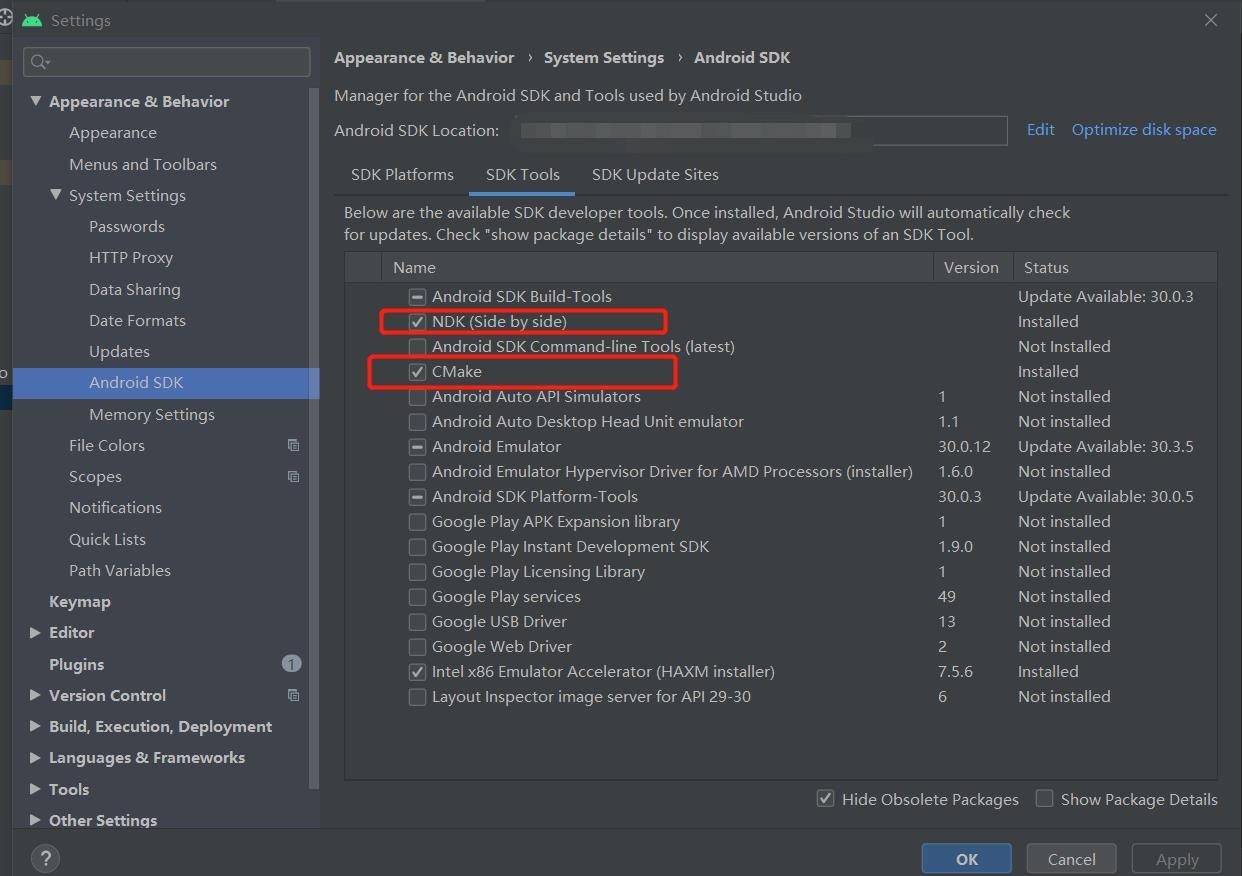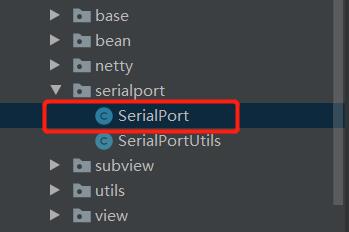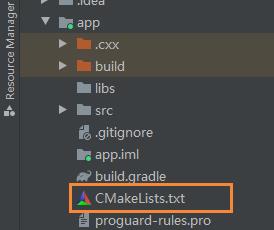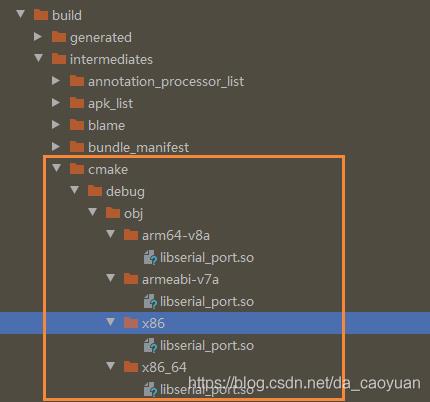Android 串口通信
Posted 吹着空调哼着歌
tags:
篇首语:本文由小常识网(cha138.com)小编为大家整理,主要介绍了Android 串口通信相关的知识,希望对你有一定的参考价值。
串口通信SerialPort
生成so文件
首先确保已经安装了NDK和CMake

然后创建一个SerialPort.java文件
主要用来处理so文件
注意包名一旦写好不要更改位置,具体代码:
import android.util.Log;
import java.io.File;
import java.io.FileDescriptor;
import java.io.FileInputStream;
import java.io.FileOutputStream;
import java.io.IOException;
import java.io.InputStream;
import java.io.OutputStream;
/**
* Created by abc on 2021/1/23.
*/
public class SerialPort
private static final String TAG = "SerialPort";
/*
* Do not remove or rename the field mFd: it is used by native method close();
*/
private FileDescriptor mFd;
private FileInputStream mFileInputStream;
private FileOutputStream mFileOutputStream;
public SerialPort(File device, int baudrate, int flags) throws SecurityException, IOException
if (device == null)
System.out.println("device is null");
return;
/* Check access permission */
if (!device.canRead() || !device.canWrite())
try
/* Missing read/write permission, trying to chmod the file */
Process su;
su = Runtime.getRuntime().exec("/system/bin/su");
String cmd = "chmod 777 " + device.getAbsolutePath() + "\\n" + "exit\\n";
su.getOutputStream().write(cmd.getBytes());
if ((su.waitFor() != 0) || !device.canRead() || !device.canWrite())
// throw new SecurityException();
catch (Exception e)
e.printStackTrace();
// throw new SecurityException();
mFd = open(device.getAbsolutePath(), baudrate, flags);
if (mFd == null)
Log.e(TAG, "native open returns null");
throw new IOException();
mFileInputStream = new FileInputStream(mFd);
mFileOutputStream = new FileOutputStream(mFd);
// Getters and setters
public InputStream getInputStream()
return mFileInputStream;
public OutputStream getOutputStream()
return mFileOutputStream;
// JNI
private native static FileDescriptor open(String path, int baudrate, int flags);
public native void close();
static
System.loadLibrary("serial_port");
然后clean project 再rebuild project 生成class文件,
这时候打开如下图的文件夹看是否生成了classes文件夹,没有生成请重新再试一遍。

当然你也不一定会生成compileDebugJavaWithJavac 只要javac->debug下存在classes就可以
再打开Terminal输入指令
cd app/build/intermediates/javac/debug/classes(具体位置定位到classes)
然后再输入指令
javah -jni 包名.SerialPort
注意 这里javah -jni后面跟的是 SerialPort.java 的全路径,如果javah报不存在之类的,是你的Java环境没有配置好。
这时候打开 debug/classes下面的文件发现多了一个以 .h 结尾文件

编写处理C文件
在main下创建一个jni包 将生成的.h文件复制进去

然后创建SerialPort.c文件
#include <stdlib.h>
#include <stdio.h>
#include <jni.h>
#include <assert.h>
#include <termios.h>
#include <unistd.h>
#include <sys/types.h>
#include <sys/stat.h>
#include <fcntl.h>
#include <string.h>
#include <jni.h>
#include 这里是生成.h文件全称(com_***_***_serialport_SerialPort.h)
#include "android/log.h"
static const char *TAG = "serial_port";
#define LOGI(fmt, args...) __android_log_print(ANDROID_LOG_INFO, TAG, fmt, ##args)
#define LOGD(fmt, args...) __android_log_print(ANDROID_LOG_DEBUG, TAG, fmt, ##args)
#define LOGE(fmt, args...) __android_log_print(ANDROID_LOG_ERROR, TAG, fmt, ##args)
static speed_t getBaudrate(jint baudrate)
switch(baudrate)
case 0: return B0;
case 50: return B50;
case 75: return B75;
case 110: return B110;
case 134: return B134;
case 150: return B150;
case 200: return B200;
case 300: return B300;
case 600: return B600;
case 1200: return B1200;
case 1800: return B1800;
case 2400: return B2400;
case 4800: return B4800;
case 9600: return B9600;
case 19200: return B19200;
case 38400: return B38400;
case 57600: return B57600;
case 115200: return B115200;
case 230400: return B230400;
case 460800: return B460800;
case 500000: return B500000;
case 576000: return B576000;
case 921600: return B921600;
case 1000000: return B1000000;
case 1152000: return B1152000;
case 1500000: return B1500000;
case 2000000: return B2000000;
case 2500000: return B2500000;
case 3000000: return B3000000;
case 3500000: return B3500000;
case 4000000: return B4000000;
default: return -1;
/*
* Class: android_serialport_SerialPort
* Method: open
* Signature: (Ljava/lang/String;II)Ljava/io/FileDescriptor;
*/
//这里同样是生成.h文件全称
JNIEXPORT jobject JNICALL Java_com_***_***_serialport_SerialPort_open
(JNIEnv *env, jclass thiz, jstring path, jint baudrate, jint flags)
int fd;
speed_t speed;
jobject mFileDescriptor;
/* Check arguments */
speed = getBaudrate(baudrate);
if (speed == -1)
/* TODO: throw an exception */
LOGE("Invalid baudrate");
return NULL;
/* Opening device */
jboolean iscopy;
const char *path_utf = (*env)->GetStringUTFChars(env, path, &iscopy);
LOGD("Opening serial port %s with flags 0x%x", path_utf, O_RDWR | flags);
fd = open(path_utf, O_RDWR | flags);
LOGD("open() fd = %d", fd);
(*env)->ReleaseStringUTFChars(env, path, path_utf);
if (fd == -1)
/* Throw an exception */
LOGE("Cannot open port");
/* TODO: throw an exception */
return NULL;
/* Configure device */
struct termios cfg;
LOGD("Configuring serial port");
if (tcgetattr(fd, &cfg))
LOGE("tcgetattr() failed");
close(fd);
/* TODO: throw an exception */
return NULL;
cfmakeraw(&cfg);
cfsetispeed(&cfg, speed);
cfsetospeed(&cfg, speed);
if (tcsetattr(fd, TCSANOW, &cfg))
LOGE("tcsetattr() failed");
close(fd);
/* TODO: throw an exception */
return NULL;
/* Create a corresponding file descriptor */
jclass cFileDescriptor = (*env)->FindClass(env, "java/io/FileDescriptor");
jmethodID iFileDescriptor = (*env)->GetMethodID(env, cFileDescriptor, "<init>", "()V");
jfieldID descriptorID = (*env)->GetFieldID(env, cFileDescriptor, "descriptor", "I");
mFileDescriptor = (*env)->NewObject(env, cFileDescriptor, iFileDescriptor);
(*env)->SetIntField(env, mFileDescriptor, descriptorID, (jint)fd);
return mFileDescriptor;
/*
* Class: cedric_serial_SerialPort
* Method: close
* Signature: ()V
*/
//这里同样是生成.h文件全称
JNIEXPORT void JNICALL Java_com_***_***_serialport_SerialPort_close
(JNIEnv *env, jobject thiz)
jclass SerialPortClass = (*env)->GetObjectClass(env, thiz);
jclass FileDescriptorClass = (*env)->FindClass(env, "java/io/FileDescriptor");
jfieldID mFdID = (*env)->GetFieldID(env, SerialPortClass, "mFd", "Ljava/io/FileDescriptor;");
jfieldID descriptorID = (*env)->GetFieldID(env, FileDescriptorClass, "descriptor", "I");
jobject mFd = (*env)->GetObjectField(env, thiz, mFdID);
jint descriptor = (*env)->GetIntField(env, mFd, descriptorID);
LOGD("close(fd = %d)", descriptor);
close(descriptor);
termios.h 具体代码:
#ifndef _TERMIOS_H_
#define _TERMIOS_H_
#include <sys/cdefs.h>
#include <sys/ioctl.h>
#include <sys/types.h>
#include <stdint.h>
#include <linux/termios.h>
__BEGIN_DECLS
/* Redefine these to match their ioctl number */
#undef TCSANOW
#define TCSANOW TCSETS
#undef TCSADRAIN
#define TCSADRAIN TCSETSW
#undef TCSAFLUSH
#define TCSAFLUSH TCSETSF
static __inline__ int tcgetattr(int fd, struct termios *s)
return ioctl(fd, TCGETS, s);
static __inline__ int tcsetattr(int fd, int __opt, const struct termios *s)
return ioctl(fd, __opt, (void *)s);
static __inline__ int tcflow(int fd, int action)
return ioctl(fd, TCXONC, (void *)(intptr_t)action);
static __inline__ int tcflush(int fd, int __queue)
return ioctl(fd, TCFLSH, (void *)(intptr_t)__queue);
static __inline__ pid_t tcgetsid(int fd)
pid_t _pid;
return ioctl(fd, TIOCGSID, &_pid) ? (pid_t)-1 : _pid;
static __inline__ int tcsendbreak(int fd, int __duration)
return ioctl(fd, TCSBRKP, (void *)(uintptr_t)__duration);
static __inline__ speed_t cfgetospeed(const struct termios *s)
return (speed_t)(s->c_cflag & CBAUD);
static __inline__ int cfsetospeed(struct termios *s, speed_t speed)
s->c_cflag = (s->c_cflag & ~CBAUD) | (speed & CBAUD);
return 0;
static __inline__ speed_t cfgetispeed(const struct termios *s)
return (speed_t)(s->c_cflag & CBAUD);
static __inline__ int cfsetispeed(struct termios *s, speed_t speed)
s->c_cflag = (s->c_cflag & ~CBAUD) | (speed & CBAUD);
return 0;
static __inline__ void cfmakeraw(struct termios *s)
s->c_iflag &= ~(IGNBRK|BRKINT|PARMRK|ISTRIP|INLCR|IGNCR|ICRNL|IXON);
s->c_oflag &= ~OPOST;
s->c_lflag &= ~(ECHO|ECHONL|ICANON|ISIG|IEXTEN);
s->c_cflag &= ~(CSIZE|PARENB);
s->c_cflag |= CS8;
__END_DECLS
#endif /* _TERMIOS_H_ */
生成so文件
首先,在项目(app)的build.gradel中的defaultConfig下添加:
externalNativeBuild
cmake
cppFlags ""
// abiFilters "armeabi-v7a", "x86", "arm64-v8a"
然后再在项目(app)的build.gradel 的 android 闭包下添加:
externalNativeBuild
cmake
path "CMakeLists.txt"
在app下创建一个CMakeLists.txt

# For more information about using CMake with Android Studio, read the
# documentation: https://d.android.com/studio/projects/add-native-code.html
# Sets the minimum version of CMake required to build the native library.
cmake_minimum_required(VERSION 3.4.1)
# Creates and names a library, sets it as either STATIC
# or SHARED, and provides the relative paths to its source code.
# You can define multiple libraries, and CMake builds them for you.
# Gradle automatically packages shared libraries with your APK.
#设置生成的so动态库最后输出的路径
set(CMAKE_LIBRARY_OUTPUT_DIRECTORY $PROJECT_SOURCE_DIR/../jniLibs/$ANDROID_ABI)
add_library( # Sets the name of the library.
#此处填入library名称,就是生成so文件的名称
serial_port
# Sets the library as a shared library.
SHARED
# Provides a relative path to your source file(s). c文件或cpp文件的相对路径
src/main/jni/SerialPort.c
)
# Searches for a specified prebuilt library and stores the path as a
# variable. Because CMake includes system libraries in the search path by
# default, you only need to specify the name of the public NDK library
# you want to add. CMake verifies that the library exists before
# completing its build.
find_library( # Sets the name of the path variable.
log-lib
# Specifies the name of the NDK library that
# you want CMake to locate.
log)
# Specifies libraries CMake should link to your target library. You
# can link multiple libraries, such as libraries you define in this
# build script, prebuilt third-party libraries, or system libraries.
target_link_libraries( # Specifies the target library.
#此处填入library名称,就是生成so文件的名称
serial_port
# Links the target library to the log library
# included in the NDK.
$log-lib)
你现在就可以Make Project 或者 Rebuild Project 一下 ,之后会在这里会生成so库:

把生成的so文件复制到libs下或者jniLibs下
这时so文件我们生成了就需要把build的注释掉不然下次运行还会生成
externalNativeBuild
cmake
cppFlags ""
// abiFilters "armeabi-v7a", "x86", "arm64-v8a"
externalNativeBuild
cmake
path "CMakeLists.txt"
然后我们封装一个SerialPortUtils
import android.util.Log;
import android.widget.Toast;
import java.io.File;
import java.io.IOException;
import java.io.InputStream;
import java.io.OutputStream;
/**
* @author renquan
*/
public class以上是关于Android 串口通信的主要内容,如果未能解决你的问题,请参考以下文章
Qt 中的qserialplot 串口通信功能如何在qt for android用?或者用Qt如何实现android版本的串口通信功能?